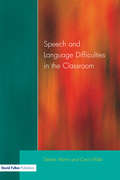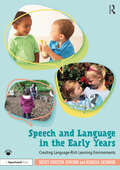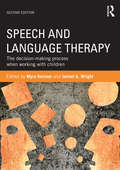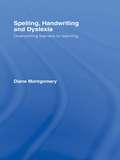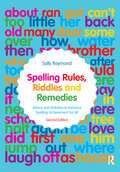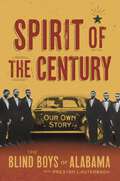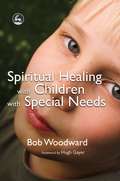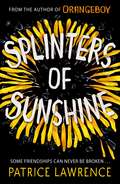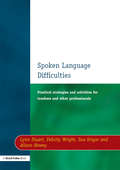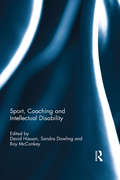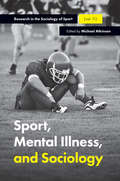- Table View
- List View
Speech and Language Difficulties in the Classroom
by Deirdre Martin Carol MillerNow fully updated and revised in the light of recent developments in practice, this book discusses children's language development and language difficulties in the context of the classroom. The book will help the practitioner to understand the range of language difficulties experienced by children and will assist them in planning appropriate activities with pupils, their parents and other education professionals. In particular, this second edition offers further guidance for teachers on observing children's communication skills in school; fully revised and updated chapters, in the light of recent research; advice for schools on the implications of the increased emphasis on language and communication needs in the revised SEN Code of Practice 2001; and discussion about the increasingly recognized links between communication difficulties and EBD.
Speech and Language Difficulties in the Classroom
by Deirdre Martin Carol MillerNow fully updated and revised in the light of recent developments in practice, this book discusses children's language development and language difficulties in the context of the classroom. The book will help the practitioner to understand the range of language difficulties experienced by children and will assist them in planning appropriate activities with pupils, their parents and other education professionals. In particular, this second edition offers further guidance for teachers on observing children's communication skills in school; fully revised and updated chapters, in the light of recent research; advice for schools on the implications of the increased emphasis on language and communication needs in the revised SEN Code of Practice 2001; and discussion about the increasingly recognized links between communication difficulties and EBD.
Speech and Language in the Early Years: Creating Language-Rich Learning Environments
by Becky Poulter Jewson Rebecca SkinnerSpeech and Language in the Early Years is an accessible resource, packed full of practical ideas and techniques to support speech and language development in young children. Learning to communicate is a dynamic process. A child needs a reason to communicate, the motivation to communicate, and, significantly, a responsive communication partner. This book will help you to develop language-rich interactions to facilitate language development in your everyday work and will encourage reflective practice in your setting. Key features include: Activities and strategies designed for busy educators to dip in and out of as part of everyday practice, promoting speech and language development as well as supporting those with speech, language, and communication needs Templates and techniques for reflective practice, supporting the creation of language-rich environments and encouraging mindful communication Chapters spanning from birth to the transition to school, each exploring different areas of the learning environment Offering readers the opportunity to extend their skills and confidence in their practice, this book is an essential resource for early years practitioners looking to facilitate quality interactions with the children in their care.
Speech and Language in the Early Years: Creating Language-Rich Learning Environments
by Becky Poulter Jewson Rebecca SkinnerSpeech and Language in the Early Years is an accessible resource, packed full of practical ideas and techniques to support speech and language development in young children. Learning to communicate is a dynamic process. A child needs a reason to communicate, the motivation to communicate, and, significantly, a responsive communication partner. This book will help you to develop language-rich interactions to facilitate language development in your everyday work and will encourage reflective practice in your setting. Key features include: Activities and strategies designed for busy educators to dip in and out of as part of everyday practice, promoting speech and language development as well as supporting those with speech, language, and communication needs Templates and techniques for reflective practice, supporting the creation of language-rich environments and encouraging mindful communication Chapters spanning from birth to the transition to school, each exploring different areas of the learning environment Offering readers the opportunity to extend their skills and confidence in their practice, this book is an essential resource for early years practitioners looking to facilitate quality interactions with the children in their care.
Speech and Language Therapy: The decision-making process when working with children
by Myra Kersner Jannet A. WrightNow in its second edition, Speech and Language Therapy: the decision-making process when working with children reveals how recent research and changes in health and education services have affected the decision-making process in the assessment and management of children with speech and language problems. With individual chapters written by experts in their field, this book: Illustrates how the decisions made by practitioners may vary within different work settings Shows how these decisions may need to be adapted when working with specific client groups Explores how such decisions are part of effective evidence-based practice Offers an overview of the skills required by the developing professional Provides insight into working as a newly qualified therapist in the current job market. Rigorously underpinned with current research and revised legislation, this is an important textbook for speech and language therapy students, potential students and specialist teachers in training. Speech and Language Therapy: the decision-making process when working with children will also be relevant to newly qualified therapists, therapists returning to the profession, specialist teachers and Special Educational Needs Coordinators.
Speech and Language Therapy: The decision-making process when working with children
by Myra Kersner Jannet A. WrightNow in its second edition, Speech and Language Therapy: the decision-making process when working with children reveals how recent research and changes in health and education services have affected the decision-making process in the assessment and management of children with speech and language problems. With individual chapters written by experts in their field, this book: Illustrates how the decisions made by practitioners may vary within different work settings Shows how these decisions may need to be adapted when working with specific client groups Explores how such decisions are part of effective evidence-based practice Offers an overview of the skills required by the developing professional Provides insight into working as a newly qualified therapist in the current job market. Rigorously underpinned with current research and revised legislation, this is an important textbook for speech and language therapy students, potential students and specialist teachers in training. Speech and Language Therapy: the decision-making process when working with children will also be relevant to newly qualified therapists, therapists returning to the profession, specialist teachers and Special Educational Needs Coordinators.
Speech Bubbles 1: Supporting Speech Sound Development in Children (Speech Bubbles 1)
by Melissa PalmerSpeech Bubbles 1 is the first set in an exciting new series of picture books designed to be used by Speech Language Therapists/Pathologists, parents/caregivers, and teachers with children who have delayed or disordered speech sound development, children receiving speech therapy, or by those wanting to provide sound awareness activities for their children. The set includes eleven picture books that each target a different speech sound within the story. The set is also accompanied by a user guide with notes for professionals and caregivers alike. Eleven different speech sounds have been chosen that are early developing sounds, or sounds commonly targeted in speech language therapy: /t/, /d/, /m/, /n/, /p/, /b/, /k/, /g/, /f/, /s/ and /s/ blends. With titles such as Who Bit My Tail?, Crocodiles Can’t Climb Trees and Ben the Bubble Bear, the stories are light and engaging, with colourful and fun pictures on every page to keep the child interested. Perfect not just for therapy, but also for encouraging early sound awareness and development, Speech Bubbles 1 will create the perfect relaxed learning and practice environment for children beginning their journey into phonological awareness, speech sounds and their positions in words.
Speech Bubbles 1 User Guide: Supporting Speech Sound Development in Children (Speech Bubbles 1)
by Melissa PalmerThis book is the supporting guide for Speech Bubbles 1,the first set in an exciting new series of picture books designed to be used by Speech Language Therapists/Pathologists, parents/caregivers, and teachers with children who have delayed or disordered speech sound development, children receiving speech therapy, or by those wanting to provide sound awareness activities for their children. This user guide contains notes for both professionals and caregivers, to support the use of one or all of the picture books in the series.
Speech Bubbles 1 User Guide: Supporting Speech Sound Development in Children (Speech Bubbles 1)
by Melissa PalmerThis book is the supporting guide for Speech Bubbles 1,the first set in an exciting new series of picture books designed to be used by Speech Language Therapists/Pathologists, parents/caregivers, and teachers with children who have delayed or disordered speech sound development, children receiving speech therapy, or by those wanting to provide sound awareness activities for their children. This user guide contains notes for both professionals and caregivers, to support the use of one or all of the picture books in the series.
Speech Bubbles 2: Supporting Speech Sound Development in Children (Speech Bubbles 2)
by Melissa PalmerSpeech Bubbles 2 is the second set in a series of picture books designed to be used by those working with children who have delayed or disordered speech sound development, children receiving speech therapy or those wanting to provide sound awareness activities for children. The set includes 12 beautifully illustrated storybooks, each targeting a different speech sound in different positions within words, and a user guide with notes on each individual story. Designed to be read aloud to the child in a therapy, classroom or home setting, the stories create a fun and engaging activity that can be returned to again and again. The full set includes: Twelve bright and engaging stories targeting the following early developing sounds and sounds frequently targeted in speech therapy: /v/, /z/, /sh/, /ch/, /h/, /y/, /j/, /r/, /l/, /w/, /r/ blends and /l/ blends. A user guide supporting the use of the stories, with individual notes on each. Perfect not just for therapy but also for encouraging early sound awareness and development, this is an engaging and invaluable resource for speech and language therapists and pathologists, parents and caregivers and teachers working with children aged 2– 8 years.
Speech Bubbles 2 User Guide: Supporting Speech Sound Development in Children (Speech Bubbles 2)
by Melissa PalmerThis book is the supporting guide for Speech Bubbles 2, an exciting series created for speech language therapists and pathologists, parents and caregivers, teachers and other professionals working with children who have delayed or disordered speech sound development. The guide contains detailed notes to support the effective use of all of the picture books in the series, targeting the following sounds: /v/, /z/, /sh/, /ch/, /h/, /y/, /j/, /r/, /l/, /w/, /r/ blends and /l/ blends. Speech Bubbles 2 is the second set in a series of picture books designed to be used by those working with children who have delayed or disordered speech sound development, children receiving speech therapy or those wanting to provide sound awareness activities for children. The set includes 12 beautifully illustrated storybooks, each targeting a different speech sound in different positions within words, and a user guide with notes on each individual story. Designed to be read aloud to the child in a therapy, classroom or home setting, the stories create a fun and engaging activity that can be returned to again and again. The full set includes: Twelve bright and engaging stories targeting the following early developing sounds and sounds frequently targeted in speech therapy: /v/, /z/, /sh/, /ch/, /h/, /y/, /j/, /r/, /l/, /w/, /r/ blends and /l/ blends. A user guide supporting the use of the stories, with individual notes on each. Perfect not just for therapy but also for encouraging early sound awareness and development, this is an engaging and invaluable resource for speech language therapists and pathologists, parents and caregivers and teachers working with children aged 2–8 years.
Speech Bubbles 2 User Guide: Supporting Speech Sound Development in Children (Speech Bubbles 2)
by Melissa PalmerThis book is the supporting guide for Speech Bubbles 2, an exciting series created for speech language therapists and pathologists, parents and caregivers, teachers and other professionals working with children who have delayed or disordered speech sound development. The guide contains detailed notes to support the effective use of all of the picture books in the series, targeting the following sounds: /v/, /z/, /sh/, /ch/, /h/, /y/, /j/, /r/, /l/, /w/, /r/ blends and /l/ blends. Speech Bubbles 2 is the second set in a series of picture books designed to be used by those working with children who have delayed or disordered speech sound development, children receiving speech therapy or those wanting to provide sound awareness activities for children. The set includes 12 beautifully illustrated storybooks, each targeting a different speech sound in different positions within words, and a user guide with notes on each individual story. Designed to be read aloud to the child in a therapy, classroom or home setting, the stories create a fun and engaging activity that can be returned to again and again. The full set includes: Twelve bright and engaging stories targeting the following early developing sounds and sounds frequently targeted in speech therapy: /v/, /z/, /sh/, /ch/, /h/, /y/, /j/, /r/, /l/, /w/, /r/ blends and /l/ blends. A user guide supporting the use of the stories, with individual notes on each. Perfect not just for therapy but also for encouraging early sound awareness and development, this is an engaging and invaluable resource for speech language therapists and pathologists, parents and caregivers and teachers working with children aged 2–8 years.
Spelling, Handwriting and Dyslexia: Overcoming Barriers to Learning
by Diane MontgomeryThis ground-breaking book argues that spelling and writing need to be given more consideration in teaching and remedial settings especially if dyslexic pupils are to be helped back up to grade level, and other pupils are to make more effective, quicker progress. Helping teachers and student-teachers to understand the valuable contribution spelling and handwriting makes to literacy development in primary and secondary schools, this book shows them how to overcome existing barriers to learning. Chapters cover key topics such as: the nature of spelling and the impact of the National Literacy Strategy the strengths and weaknesses of existing schemes for handwriting the definitions of dyslexia and how common spelling errors by dyslexics are made making effective links between strategic assessment and strategic interventions in schools problem-based learning, underpinned by plenty of casestudies and real life classroom examples. Written by a well-known author in the field of literacy and dyslexia, this is a core text that will interest teachers, teacher educators, and undergraduate and postgraduate students in education and inclusion.
Spelling, Handwriting and Dyslexia: Overcoming Barriers to Learning
by Diane MontgomeryThis ground-breaking book argues that spelling and writing need to be given more consideration in teaching and remedial settings especially if dyslexic pupils are to be helped back up to grade level, and other pupils are to make more effective, quicker progress. Helping teachers and student-teachers to understand the valuable contribution spelling and handwriting makes to literacy development in primary and secondary schools, this book shows them how to overcome existing barriers to learning. Chapters cover key topics such as: the nature of spelling and the impact of the National Literacy Strategy the strengths and weaknesses of existing schemes for handwriting the definitions of dyslexia and how common spelling errors by dyslexics are made making effective links between strategic assessment and strategic interventions in schools problem-based learning, underpinned by plenty of casestudies and real life classroom examples. Written by a well-known author in the field of literacy and dyslexia, this is a core text that will interest teachers, teacher educators, and undergraduate and postgraduate students in education and inclusion.
Spelling Rules, Riddles and Remedies: Advice and Activities to Enhance Spelling Achievement for All
by Sally RaymondSpelling Rules, Riddles and Remedies is for anyone supporting learners who are struggling to understand the world of English spellings. This book engages learners and enhances their learning by using practical and dynamic resources to reveal the cause and effect of spelling confusions. By posing opportunities for understanding memory-related applications, learners and their spelling tutors are empowered with the knowledge and resources required to amend, improve and proliferate spelling success. In this revised edition, bestselling author Sally Raymond offers further unique and accessible 'Spelling Detective' and 'Learning Application' activities and explores ways of empowering individual learners. Offering a wealth of effective approaches to improving spelling, chapters: demonstrate how spelling errors can be examined to develop solutions for individual learners; show how to engage pupils through use of meta-cognition; highlight the reasons why spelling abilities might fail; explore and resolve the impact of English spelling irregularities and deviations through informed discovery; illustrate how to use mnemonics and story-lines to link tangible prompts to confident spelling ability; provide structured game-play and challenging practice lessons. boost pupils’ achievement through the strategic use of multiple processing skills. Clearly presented and highly illustrated, this book encourages creativity and shows teachers how to adopt and adapt a variety of learning strategies to suit different needs. Targeting learners in Key Stage 2 upwards, Spelling Rules, Riddles and Remedies brings a wealth of ideas to stimulate spelling success.
Spelling Rules, Riddles and Remedies: Advice and Activities to Enhance Spelling Achievement for All
by Sally RaymondSpelling Rules, Riddles and Remedies is for anyone supporting learners who are struggling to understand the world of English spellings. This book engages learners and enhances their learning by using practical and dynamic resources to reveal the cause and effect of spelling confusions. By posing opportunities for understanding memory-related applications, learners and their spelling tutors are empowered with the knowledge and resources required to amend, improve and proliferate spelling success. In this revised edition, bestselling author Sally Raymond offers further unique and accessible 'Spelling Detective' and 'Learning Application' activities and explores ways of empowering individual learners. Offering a wealth of effective approaches to improving spelling, chapters: demonstrate how spelling errors can be examined to develop solutions for individual learners; show how to engage pupils through use of meta-cognition; highlight the reasons why spelling abilities might fail; explore and resolve the impact of English spelling irregularities and deviations through informed discovery; illustrate how to use mnemonics and story-lines to link tangible prompts to confident spelling ability; provide structured game-play and challenging practice lessons. boost pupils’ achievement through the strategic use of multiple processing skills. Clearly presented and highly illustrated, this book encourages creativity and shows teachers how to adopt and adapt a variety of learning strategies to suit different needs. Targeting learners in Key Stage 2 upwards, Spelling Rules, Riddles and Remedies brings a wealth of ideas to stimulate spelling success.
Spirit of the Century: Our Own Story
by The Blind Boys of AlabamaAn insider history of the Blind Boys of Alabama, the longest running group in American music, and the untold story of their world, written with band members and key musical colleagues. The Blind Boys of Alabama are the quintessential Gospel vocal group, and the longest-running musical institution in America. Their story intersects with pivotal moments and issues in American history and is an ideal prism through which to trace music, culture, history, and race in America. Spirit of the Century invites readers to follow along the Blind Boys&’ eight-decade journey together from a segregated trade school, through the rough and tumble indie record game and grinding tour schedule of the golden age of gospel, to starring in an iconic Broadway musical, performing at the White House for three presidents twice, collaborating with Tom Petty, Lou Reed, and Ben Harper, among others, singing the theme song for &“The Wire,&” and winning five Grammys. More than just a story of the Blind Boys' illustrious career, Spirit of the Century also sheds new light on the larger world of African American gospel music, its origins, and the colorful characters at its center. Though there have been several iterations of the group over the decades, Spirit of the Century rounds up all surviving members of the group as contributors to the telling of their own story, and a result, the book offers a unique and intimate perspective on the group's enduring success. Current drummer and road manager Rickie McKinney has been with the group throughout its renaissance, while guitarist Joey Williams, the group&’s sighted member, has been the eyes of the Blind Boys since 1992. Octogenarian Jimmy Lee Carter has a fascinating history, as a fellow student of the original but deceased Blind Boys Clarence Fountain, George Scott, Olice Thomas, Johnny Fields, J.T. Hutton, and Velma Traylor at the Talladega school. Carter is one of a few performers who have been in both the Blind Boys of Alabama and Mississippi. He fronts the Alabama group today as a classic quartet leader and fiery preacher. Along with extensive interviews of Fountain, these legendary musicians provide this book with the voice, firsthand perspective, and authenticity that bring their story the same inspirational power that you hear in their songs. Thought-provoking, heartfelt, and deeply inspiring, Spirit of the Century is a fascinating and one-of-a-kind read that you won't be able to put down.
Spiritual Healing with Children with Special Needs (PDF)
by Bob Woodward'Bob Woodward, a respected member of the National Federation of Spiritual Healers, and a senior co-worker at the Sheiling School, a Camphill Centre, draws on the practice both as a healer and curative educator in order to share key concepts of both areas of experience with the reader. Examples of individual healing sessions with children with a variety of special needs demonstrate the part that spiritual healing can play in calming emotional disturbance, and helping to restore harmony to body, soul and spirit: a marked improvement in the ability to relate to both peers and adults was noticed by carers and teacher.' - The Christian Parapsychologist Spiritual Healing with Children with Special Needs gives a fascinating account of individual healing sessions with children with complex special needs and moderate to severe learning difficulties. Drawing on his experience as a qualified spiritual healer and senior co-worker at The Sheiling School, a Camphill Centre, Bob Woodward shows how spiritual healing can help children with special needs to achieve peace and relaxation. From his perspective as both spiritual healer and curative educator, the author introduces the key concepts of both subject areas to the reader and explains how the two disciplines can be combined and applied, providing case examples of healing sessions with children with a range of special needs, including autism, epilepsy and emotional and behavioural difficulties. The author demonstrates the benefits of spiritual healing for these children as a natural, non-invasive, holistic approach that restores balance and harmony to body, soul and spirit. This unique book will be of interest to parents and professionals involved with special needs children, as well as practitioners of and those interested in spiritual healing.
Splinters of Sunshine
by Patrice LawrenceFrom the multi-award-winning author of Orangeboy, comes a YA road-trip mystery. After a fun Christmas Eve decorating the tree and singing along with his mum to Queen, fifteen-year-old Spey wakes up on Christmas morning to find the ex-prisoner father he's never met asleep on the sofa.Then he receives a mysterious package in the post: a torn envelope filled with half a collage he made with his old friend Dee on her sixth birthday. Dee bounced between schools and pupil referral units until a tragedy meant she ended up in care outside of London, drawn into the world of county lines gangs. They haven't spoken for years, but Spey is sure she must be in danger. He just doesn't know where she is.There's only one person Spey can think of who might be able to help ... On a roadtrip like no other, can Spey and his dad find Dee, and will they be ready to confront a criminal gang together?
Spoken Language Difficulties: Practical Strategies and Activities for Teachers and Other Professionals
by Lynn Stuart Felicity Wright Sue Grigor Alison HoweyIntended as a practical approach to helping children who have spoken language difficulties because of general language delay or specific language impairment, this book contains ideas and activity sheets as well as structured guidance. Areas of language difficulty are identified, activities are suggested to meet these language needs and all this is supported by a developmental framework. This book also provides advice on classroom management and grouping, in addition to a bank of individual targets for IEPs which are linked to the activities and strategies suggested within the book. Suitable for non-specialists and specialists alike, many professionals find this book to be an invaluable resource, including mainstream teachers, teaching assistants, speech and language therapists working in schools, SENCOs, nursery nurses and special school teachers.
Spoken Language Difficulties: Practical Strategies and Activities for Teachers and Other Professionals
by Lynn Stuart Felicity Wright Sue Grigor Alison HoweyIntended as a practical approach to helping children who have spoken language difficulties because of general language delay or specific language impairment, this book contains ideas and activity sheets as well as structured guidance. Areas of language difficulty are identified, activities are suggested to meet these language needs and all this is supported by a developmental framework. This book also provides advice on classroom management and grouping, in addition to a bank of individual targets for IEPs which are linked to the activities and strategies suggested within the book. Suitable for non-specialists and specialists alike, many professionals find this book to be an invaluable resource, including mainstream teachers, teaching assistants, speech and language therapists working in schools, SENCOs, nursery nurses and special school teachers.
Sport, Coaching and Intellectual Disability
by David Hassan Sandra Dowling Roy McConkeyThere are more opportunities than ever before for young people with disabilities to participate in sport and adapted physical education. For example, there are more than 3.7 million athletes worldwide aligned to the Special Olympics organisation, with national associations active in more than 200 countries worldwide. Despite this rapid growth, all too often coaches and teachers lack adequate knowledge of the particular challenges faced by people with intellectual disabilities. The principal aim of this book is to improve the understanding and professional skills of coaches, teachers, practitioners and researchers, to promote awareness of successful programmes addressing the needs of such young people, and to challenge the prevailing myths and stereotypes surrounding their abilities. With contributions from leading researchers and practitioners around the world, this book is the first to explore in depth the topic of sport and intellectual disability from a coaching perspective. Including both theoretical discussion and empirical case-studies, the book covers a full range of contemporary issues and themes, including training and coaching, family support, perceptions of disability, athlete motivation, positive sport experiences, motor development programmes, and social and cultural aspects of disability. Sport Coaching and Intellectual Disability is important reading for any student, researcher, coach, teacher, manager or policy maker with an interest in disability sport, physical education, coaching, or mainstream disability studies.
Sport, Coaching and Intellectual Disability
by David Hassan Sandra Dowling Roy McConkeyThere are more opportunities than ever before for young people with disabilities to participate in sport and adapted physical education. For example, there are more than 3.7 million athletes worldwide aligned to the Special Olympics organisation, with national associations active in more than 200 countries worldwide. Despite this rapid growth, all too often coaches and teachers lack adequate knowledge of the particular challenges faced by people with intellectual disabilities. The principal aim of this book is to improve the understanding and professional skills of coaches, teachers, practitioners and researchers, to promote awareness of successful programmes addressing the needs of such young people, and to challenge the prevailing myths and stereotypes surrounding their abilities. With contributions from leading researchers and practitioners around the world, this book is the first to explore in depth the topic of sport and intellectual disability from a coaching perspective. Including both theoretical discussion and empirical case-studies, the book covers a full range of contemporary issues and themes, including training and coaching, family support, perceptions of disability, athlete motivation, positive sport experiences, motor development programmes, and social and cultural aspects of disability. Sport Coaching and Intellectual Disability is important reading for any student, researcher, coach, teacher, manager or policy maker with an interest in disability sport, physical education, coaching, or mainstream disability studies.
Sport, Mental Illness and Sociology (Research in the Sociology of Sport #11)
by Michael AtkinsonAt a time when the public discussion of mental illness in society is reaching a high point, athletes and other sports insiders remain curiously silent about their private battles with a range of mental illnesses. While a series of professional athletes have exposed the deep, dark secret related to the pervasiveness of mental illness in high performance sport, relatively little is known, sociologically, about what mental illness culturally means inside sport. This edited collection showcases research on how sport, as a social institution, may actually produce dangerous cultural practices and contexts that foster the development of mental illness within athlete groups. Further, chapters also illustrate how sport, when organized with sensitivity and care, may serve to help manage mental illnesses. Rather than analyzing mental illness as an individual phenomenon, contributors to this volume equally attest to how mental illness is socially developed, constructed, managed, and culturally understood within sport settings. The book highlights the relevance of a range of theories pertinent to the social study of mental illness including dramaturgy, cultural studies, learning theory, symbolic interaction, existentialism, and total pain theory. Chapters range from the discussion of depression, anxiety, eating disorders, drug addiction, epilepsy, mental trauma, stigma, the mass mediation of mental illness, and the promise of sport as a vehicle for personal and collective recovery.
Sport, Mental Illness and Sociology (Research in the Sociology of Sport #11)
by Michael AtkinsonAt a time when the public discussion of mental illness in society is reaching a high point, athletes and other sports insiders remain curiously silent about their private battles with a range of mental illnesses. While a series of professional athletes have exposed the deep, dark secret related to the pervasiveness of mental illness in high performance sport, relatively little is known, sociologically, about what mental illness culturally means inside sport. This edited collection showcases research on how sport, as a social institution, may actually produce dangerous cultural practices and contexts that foster the development of mental illness within athlete groups. Further, chapters also illustrate how sport, when organized with sensitivity and care, may serve to help manage mental illnesses. Rather than analyzing mental illness as an individual phenomenon, contributors to this volume equally attest to how mental illness is socially developed, constructed, managed, and culturally understood within sport settings. The book highlights the relevance of a range of theories pertinent to the social study of mental illness including dramaturgy, cultural studies, learning theory, symbolic interaction, existentialism, and total pain theory. Chapters range from the discussion of depression, anxiety, eating disorders, drug addiction, epilepsy, mental trauma, stigma, the mass mediation of mental illness, and the promise of sport as a vehicle for personal and collective recovery.
